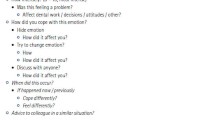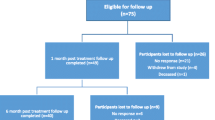Abstract
This study evaluated the effects of giving patients treatment-relevant choices, and the influence of provider–patient interpersonal behaviors, on patients' adjustment to and satisfaction with a protracted healthcare procedure. 102 patients receiving complete dentures were randomly assigned to a Decisional Control group, a No-Decisional Control group, or to a Treatment as Usual Control group. No main effects for the “control” manipulations were obtained, and interactions obtained between control conditions and patient dispositional differences in locus of control were not consistent with earlier findings. Dentists' and patients' interpersonal appraisals of each other, as measured by the Impact Message Inventory, were the most significant factors accounting for patient outcome differences. Consistent with previous research, the experience of oppressive interpersonal impacts both by patients (physician low friendliness) and dentists (patient low friendliness, high dominance, high hostility) were associated with poorer patient outcomes.
Similar content being viewed by others
References
Auerbach, S. M. (1989). Stress management and coping research in the health care setting: An overview and methodological commentary. J. Consult. Clin. Psychol. 57: 388-395.
Auerbach, S. M. (2000). Should patients have control over their own health care?: Empirical evidence and research issues. Ann. Behav. Med. 22: 246-259.
Auerbach, S. M. (2001). Do patients want control over their own health care?: A review of measures, findings, and research issues. J. Health Psychol. 6: 191-203.
Auerbach, S. M., Clore, J. N., Kiesler, D. J., Orr, T., Pegg, P., Quick, B., and Wagner, C. (2002). Relation of diabetic patients' health-related control appraisals and physician–patient interpersonal impacts to patients' metabolic control and satisfaction with treatment. J. Behav. Med. 25: 17-31.
Auerbach, S. M., Kendall, P. C., Cuttler, H., and Levitt, N. R. (1976). Anxiety, locus of control, type of preparatory information, and adjustment to dental surgery. J. Consult. Clin. Psychol. 44: 809-818.
Auerbach, S. M., Martelli, M., and Mercuri, L. G. (1983). Anxiety, information, interpersonal impacts, and adjustment to a stressful health care situation. J. Pers. Soc. Psychol. 44: 1284-1296.
Auerbach, S. M., Meredith, J., Alexander, J. M., Mercuri, L. G., and Brophy, C. (1984). Psychological factors in adjustment to orthognathic surgery. J. Oral Maxillofac. Surg. 42: 435-440.
Auerbach, S. M., and Pegg, P. (2002). Appraisal of desire for control over healthcare: Structure, stability, and relation to health locus of control and to the “big five” personality traits. J. Health Psychol. 7: 393-408.
Baltes, M. M., and Baltes, P. B. (1986). The Psychology of Control and Aging, Erlbaum, Hillsdale, NJ.
Beisecker, A. E., Helmig, L., Graham, D., and Moore, W. P. (1994). Attitudes of oncologists, oncology nurses, and patients from a women's clinic regarding medical decision making for older and younger breast cancer patients. Gerontologist 34: 505-512.
Beisecker, A. E., Murden, R. A., Moore, W. P., Graham, D., and Helmig, L. C. (1996). Attitudes of medical students and primary care physicians regarding input of older and younger patients in medical decisions. Med. Care 34: 126-137.
Bilodeau, B. A., and Degner, L. F. (1996). Information needs, sources of information, and decisional roles in women with breast cancer. Oncol. Nurs. Forum 23: 691-696.
Biondo, J., and MacDonald, A. P. (1971). Internal–external locus of control and response to influence attempts. J. Pers. 39: 407-409.
Braddock, C. H., Edwards, K. A., Hasenberg, N. M., Laidley, T. L., and Levinson, W. (1999). Informed decision-making in outpatient practice: Time to get back to basics. JAMA 282: 2313-2320.
Bradley, C. (1993). Designing medical and educational intervention studies: A review of some alternatives to conventional randomized control trials. Diabetes Care 16: 509-518.
Cohen, S., and Edwards, J. F. (1989). Personality characteristics as moderators of the relationship between stress and disorder. In Neufeld, R. J. (Eds.), Advances in the Investigation of Psychological Stress Wiley, New York, (pp. 253-283).
Cromwell, R. L., Butterfield, E. C., Brayfield, F. M., and Curry, J. J. (1977). Acute Myocardial Infarction: Reaction and Recovery, Mosby, St. Louis, MS.
Derogatis, L. B. (1977). The SCL-90-Revised, Manual I, Johns Hopkins University School of Medicine, Baltimore, MD.
Frantsve, L. M. E. (2002). Effects of Enhanced Decisional Control on Patients' Adjustment to and Recovery From Oral Surgery, Doctoral Dissertation, Virginia Commonwealth University, Richmond, VA.
Greenfield, S., Kaplan, S., and Ware, J. E. (1985). Expanding involvement in patient care: Effects on patient outcomes. Ann. Intern. Med. 102: 520-528.
Guckes, A. D., Smith, D. E., and Swope, C. C. (1978). Counseling and related factors influencing satisfaction with dentures. J. Prosthet. Dent. 39: 259-267.
Kiesler, D. J. (1983). The 1982 interpersonal circle: A taxonomy for complementarity in human transactions. Psychol. Rev. 90: 185-214.
Kiesler, D. J. (1996). Contemporary Interpersonal Theory and Research: Personality, Psychopathology and Psychotherapy, Wiley, New York.
Kiesler, D. J., Anchin, J. C., Perkins, M. J., Chirico, B. M., Kyle, E. M., and Federman, E. J. (1985). The Impact Message Inventory: Form II. Consulting Psychologists Press, Palo Alto, CA.
Kiesler, D. J., and Auerbach, S. M. (2003). Integrating measurement of control and affiliation in studies of physician–patient interaction: The interpersonal circumplex. Soc. Sci. Med. 57: 1707-1722.
Kiesler, D. J., and Schmidt, J. A. (1993). The Impact Message Inventory: Form IIA Octant Scoring Version, Mind Garden, Redwood City, CA.
Lazure, L. L., and Baun, M. M. (1995). Increasing patient control of family visiting in the coronary care unit. Am. J. Crit. Care 4: 157-164.
Lefcourt, H. M. (Eds.) (1981). Research With the Locus of Control Construct. Vol. 1: Assessment Methods, Academic Press, New York.
Llewellyn-Thomas, H. A., McGreal, M. J., Thiel, E. C., Fine, S., and Erlichman, C. (1991). Patients' willingness to enter clinical trials: Measuring the association with perceived benefit and preference for decision participation. Soc. Sci. Med. 32: 35-42.
Phillips, C. (1999). Patient-centered outcomes in surgical and orthodontic treatment. Semin. Orthod. 5: 223-230.
Rotter, J. R. (1966). Generalized expectancies for internal versus external control of reinforcement. Psychol. Monogr. 80: 1-28.
Schmidt, J. A., Wagner, C. C., and Kiesler, D. J. (1999). Psychometric properties of the octant scale Impact Message Inventory (IMI-C): A structural evaluation. J. Couns. Psychol. 46: 325-334.
Selden, H. S. (1993). Patient empowerment: A strategy for pain management in endodontics. J. Endod. 19: 521-523.
Snow, R. M. (1982). Denture Locus of Control Scale, University of Washington Dental School, Seattle, WA.
Tarbox, B. B., Rockwood, J. K., and Abernathy, C. M. (1992). Are modified radical mastectomies done for T1 breast cancers because of surgeon's advice or patient's choice? Am. J. Surg. 164: 417-422.
Taylor, N., Hall, G. M., and Salmon, P. (1996). Is patient-controlled anesthesia controlled by the patient? Soc. Sci. Med. 43: 1137-1143.
Thompson, S. C. (1981). Will it hurt less if I can control it? A complex answer to a simple question. Psychol. Bull. 90: 89-101.
Wallston, K. A., Wallston, B. S., Smith, M. S., and Dobbins, C. J. (1987). Perceived control and health. Curr. Psychol. Res. Rev. 6: 5-25.
Wilson, G. T. (1979). Perceived control and the theory and practice of behavior therapy. In Perlmutter, L. C., and Monty, R. A. (Eds.), Choice and Perceived Control. Erlbaum, Hillsdale, NJ.
Author information
Authors and Affiliations
Corresponding author
Rights and permissions
About this article
Cite this article
Auerbach, S.M., Penberthy, A.R. & Kiesler, D.J. Opportunity for Control, Interpersonal Impacts, and Adjustment to a Long-Term Invasive Health Care Procedure. J Behav Med 27, 11–29 (2004). https://doi.org/10.1023/B:JOBM.0000013641.64651.16
Issue Date:
DOI: https://doi.org/10.1023/B:JOBM.0000013641.64651.16




